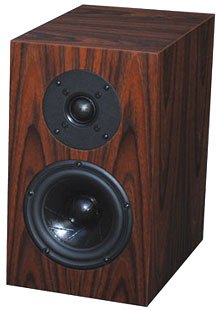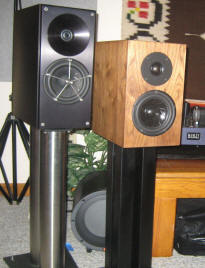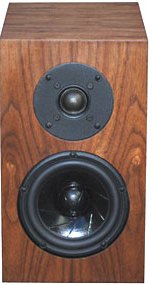Why do loudspeakers cost so damn much money? After all, you take a wood box, cut holes for the woofer and tweeter, add a few common resistors and capacitors and inductors, and you are done! This 2-way speaker can be found for $100 or $1,000 or $10,000 or even more than $40,000 per pair. Now I am not going to sit here and give you a lecture on the economics of a manufacturing business, nor talk about the obvious costs associated with building a better quality box with more expensive parts. But what I have always wondered about, and I’ll bet that many of you have wondered the exact same thing, is why can’t we find a speaker that provides the build quality of a very good speaker that costs just the difference between average drivers and outstanding drivers? Well, why?

Many of you are speaker builders or know something about woofers and tweeters. Looking at a brand such as ScanSpeak, a company that makes excellent drivers used by many of the better loudspeaker manufacturers, we can see that they offer a range of products. ScanSpeak makes tweeters starting at about $60 per pair retail and topping out at about ten times that amount. It is almost the same with their smaller woofers. So if I can buy a “budget” version of a finished speaker for, say $1,000, I would love to be able to buy a super maxed out version using state-of-the-art drivers for about $3,000 which simply adds the cost of the better drivers and an upgrade to better capacitors and some other parts.
We have all heard relatively inexpensive speakers that sound better than more costly models which suggests that higher cost does not guarantee better sound. Building great speakers is not simply finding the most expensive drivers, plugging their specs into a crossover-design software program and starting up the saw and soldering iron. If that were true, we would be buying our speakers from DIY companies like Madisound and Parts Express instead of from the manufacturers you already know. There is obviously an art to building great sounding speakers which is based on the designer’s ability to transform technology into music. Fortunately, there is a company that more or less follows the pricing model above and offers truly high-end performance at lower-end prices. Welcome to the world of Fritz Speakers.
John “Fritz” Heiler not only provides outstanding value in his range of speakers but, in many models including the REV5, uses a crossover technology that is rare in the marketplace. Probably 99.9% of the speakers available today use the standard 1st- or 2nd- or 3rd -order parallel crossovers which separates the frequencies going to each driver, dissecting the music into its frequency-related parts. This type of crossover uses big, expensive and power robbing capacitors in the signal path of the tweeters, and big, expensive and power robbing inductors (coils) in the signal path of the woofers. In complex higher order, i.e. 2nd, 3rd, etc., crossovers, the result is often a reduction in dynamics and a discontinuous and non-musical sound quality from the extreme phase shifts that are inherent in high order crossovers. Enter the series crossover. An excellent discussion of parallel and series crossover networks can be found here.
In the 2-way rear-ported REV5, Fritz implements a very simple series crossover that does not have any capacitors in the signal path of the tweeter. Implemented correctly by a speaker design team (which includes a female listener) with excellent sensibilities, this series crossover sounds fantastic and reduces the cost of the crossover components significantly. My desire to review the REV5 comes from long experience owning the $17,000 YG Acoustics Kipod Main Modules speakers and asking the question above. The $1,950 Fritz Speakers REV5 also uses a ScanSpeak Revelator 5” woofer – although a different model – along with the highly-rated ScanSpeak 9500 soft-dome tweeter. Their size is a room friendly 13″H x 7.5″W x 12″D and they weigh a substantial 24 pounds each. The real wood veneers are expertly applied and look beautiful. Fritz Speakers have magnetically attached grills so there are no visible fasteners when the speakers are used without their grilles. Fritz Speakers offers a 30-day home trial with full return privileges.
Other components on hand during the audition included a SOTA Cosmos vacuum turntable with Triplanar VII u2 tonearm, SOTA Satellite turntable with the new Origin Live Zephyr tonearm, Miyajima Kansui, Shilabe and Premium Mono phono cartridges, Mark Levinson No. 326S preamplifier with built-in phono stage, Rogue Ares phono preamplifier, NAD C165BEE preamplifier, Prism Orpheus Digital Interface with custom Windows 7 computer/music server, YG Acoustics Kipod Main Modules speakers, Dali Mentor 5 speakers (from the home theater system), and Gallo TR-3 subwoofers. Power amplifiers included Bryston 7B SST2s, Aesthetix Atlas, Levinson 532H, B&K Reference 125.2, and Manley Snappers. All interconnects and speaker cables are Mogami, which is recommended by Aesthetix as some of the internal wiring is Mogami. All front end components, including the preamplifiers, receive their AC power from a PS Audio AV-5000 power conditioner which is connected to the wall power with a 1 meter length of PS Audio PerfectWave AC-12 or AC-10 power cord. An Audience aR2p-TO power conditioner is normally used for the power amplifiers, and a PS Audio Quintet appeared later in the audition to provide triggered on/off power to the Manleys.
The Fritz Speakers were installed in the same positions as the YG Acoustics: about 3 feet from the back wall and 7 feet apart. Old 22″ high 4-post sand filled Plateau stands provided support. Small spacers, of the exact mass, dimensions and color of NOS #2 pencils, were placed under the front edge to raise the front of the speakers so they pointed at the listening seat. The REV5s were toed in so that I could just see the inside sides of the speakers. Since series crossovers do not split the signal to each driver at the input, they do not accommodate bi-wiring and just a single pair of binding posts can be found on the back of each speaker. This fits with the 10Audio preference for single wiring loudspeakers.
So there I was, listening to the REV5s with and without the Gallo Acoustics TR3 subwoofers and enjoying the sound either way. I took a break for dinner and then, after listening to another side of an LP, decided to turn off the subs for a little while. When I went over to the sub, lo and behold, I saw that they were just as I left them before dinner: unplugged! Sure, the 10” ceramic woofers in the Gallo subs went deeper into the low bass and had more sheer power, but the ported REV5s offered such an enjoyable presentation that the lack of the lowest bass could often be ignored in my medium sized, 1500 cubic foot listening room. In a smaller room, I dare say that one could be very satisfied with the 45 Hz-rated bass reproduction of the REV5s, even without a full measure of the lowest ½ octave. This never happened with the 50% more expensive Merlin TSM-MMe speakers as the Merlin’s rolloff in the lower frequencies strongly recommended the presence of subwoofers. Maybe this is a result of the rear port on the REV5 and the way the bass couples to the listening room. The REV5’s bass goes deep with great tone and presence.

The REV5s are very dynamic and offer very nearly the slam and energy of the 10 times more expensive Kipod Main Modules. If you keep in mind that the dynamic performance of the aluminum encased Kipods is one of their best features, it is apparent the REV5s attain a very high level of performance in this very important parameter. (Did you notice that I used the word “very” four times in this paragraph? Superlatives appear regularly when discussing the REV5s.)
The sense of space and ambience is excellent. Listen to Allan Parson’s “Snake Eyes” on Turn of a Friendly Card. Close your eyes. The feeling of being in a real casino with low ceilings and random sounds from every direction is unmistakable. On Jimmy Buffet’s “Wonder Why We Never Go Home” on the Changes in Latitudes, Changes in Attitudes LP, the harmonica floats in space, beautifully presented by the REV5s. The instrument seems to be emanating from a location about 4 feet above and 2 feet behind the speakers.
I was enthralled by the sound of “Five Corners” on the Doobie Brothers Sibling Rivalry CD. The perfect continuity from mid bass to the upper treble is readily apparent. The only demerit is in the upper treble where the sound is just a bit muted compared to the lower frequencies. However, this small trait is perfectly synergistic with many real world power amplifiers that have a bit of extra crispness in the upper frequencies. These amps are not actually grainy, just not as smooth and refined as much more expensive models. If you are hearing harshness, glare or any anomaly in a narrow frequency range then your amp is either technologically outdated or it is defective.
Often shaking my head in amazement at the high quality sound coming from these low cost speakers, I greatly enjoyed the clear sense of fully formed bass instruments with their primary tone fully intact and very proper harmonic content in the upper bass and lower midrange. Here’s one for you: “Mister Man” from Colour By Numbers by Culture Club. This cut is a real toe-tapper. You probably know the lead singer: Boy George. Check it out! The drums in “Victims” on the same CD are very impactful, resonant, and realistic. The clarity of the bass drum would be excellent from a 10 inch woofer: from the REV5’s 5 inch woofers it is simply astonishing.
More sonic delights are found in the Allman Brothers “Les Brers In A Minor” on the Eat a Peach LP. The cymbal work is so alive and shimmering that the air in my listening room seemed to crackle with energy. The REV5s delivered that saxophone up front and personal. The speakers themselves are not hot or forward sounding, but they surely can sound that way if the music requires it. They are just too well balanced to make a habit of it. Indeed, they are somewhat warmer and smoother sounding than the razor sharp Kipods which makes the Fritz Speakers more compatible with a wider range of associated components. This outstanding balance between smoothness and detail delivers music that has a great sense of ease and purity without ever being boring.

Listen to “The Rain Song” on Led Zeppelin’s Houses of the Holy. Can you hear the effects of the crossover in the region around 3kHz? Sorry, I am playing a joke on you: the transition between woofer and tweeter is completely inaudible! This shows that “Fritz” Heiler is a great speaker designer. So stick around for the opening few bars of “Over the Hills and Far Away” and revel in the fully resolved sound of the guitar strings being plucked. This excellent micro-dynamic ability of the Fritz Speakers materialized that guitar in the room. It is the same with the drums in the first 90 seconds of “No Quarter”.
The high resolution and liquid midrange and upper frequencies are usually only available from much more expensive speakers. I would like to share with you two more examples of the very musical performance of the REV5s. On Bonnie Raitt’s Luck of the Draw CD, “One Part Be My Lover” showcases the truly high-end sound with excellent resolution of the bells and a naturally warm and deeply saturated sonic character. Bonnie’s distinctive voice is beautifully reproduced. On the Doors’ Morrison Hotel from the recently released 7-LP boxed set, Jim Morrison’s voice has wonderful personality and depth on “The Spy”. He could have been the Frank Sinatra of his generation. Well done, Fritz!
Feeling devilish, I wanted to hear the speakers played at their limits and switched the speaker cables from the 100 Watt Snappers to the 300 Watt Levinson 532H amplifier. The Snappers have more than enough power for any normal listening, even for the 85dB sensitivity of the REV5s. At abnormally high sound pressure levels, the 5” woofer approached its limits as some congestion became apparent. It was not so much that the midrange lost control, but a difference in character between the woofer’s upper midrange and the tweeter’s lower treble became noticeable. I attributed this effect to the onset of Intermodulation Distortion resulting from the little woofer working too hard. To take some of the load off, I followed a long-used tweak here on 10Audio and plugged the rear port, transforming the ported speaker into a sealed box speaker. This reduced the low end extension by about 15 Hz while noticeably limiting the excursions of the woofer cone. Relieved of the lowest bass at high volume levels, the upper midrange regained its excellent clarity and again merged seamlessly with the tweeter. The integration of the woofer and tweeter is perfect at any normal listening level.
Often reviews compare components in the same general price range, or maybe 2 or 3 times more expensive. The reference speakers during this review cost about 10 times more, and they were better, but not fundamentally different sounding overall. A little more sparkle and better resolution. I dare say that anyone who heard the Kipods next to the REV5s would have some difficulty justifying – or understanding – the price difference. I listened to the remarkable REV5s day after day without feeling any urgency to switch speakers and that alone says a lot about their outstanding musicality. The REV5s would be in a strong competitive position if they sold for $5,000. At their asking price, they are one of the biggest bargains in today’s audio marketplace. They are not only good for the money, they are truly outstanding.
Overall Rating: 9 LPs, borderline 9.5 LPs
Link to Fritz Speakers
Link to REV5 page
